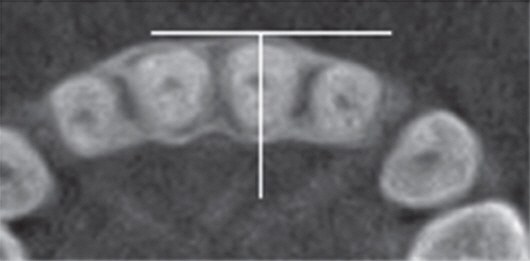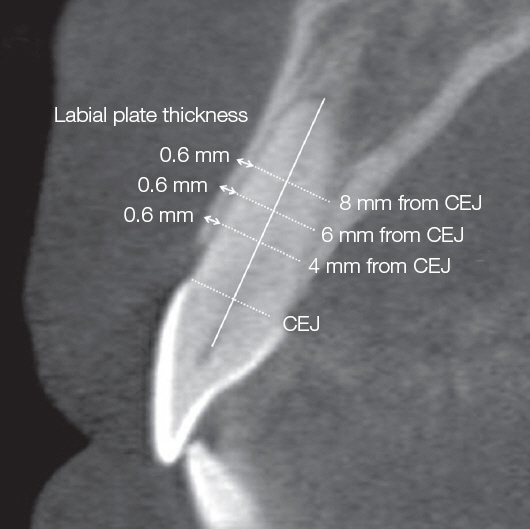J Dent Rehabil Appl Sci.
2015 Sep;31(3):169-177. 10.14368/jdras.2015.31.3.169.
Relationship between the facial bone thickness and gingival biotype of the anterior maxilla in Koreans
- Affiliations
-
- 1Department of Periodontology, School of Dentistry, Pusan National University, Yangsan, Republic of Korea. heroine@pusan.ac.kr
- KMID: 2180012
- DOI: http://doi.org/10.14368/jdras.2015.31.3.169
Abstract
- PURPOSE
The objects of this study were to examine the thickness of labial plate of anterior maxillary teeth and the gingival biotype in Koreans and to evaluate whether there is a correlation between the gingival biotype and the thickness of labial plate.
MATERIALS AND METHODS
This study was performed on 335 teeth of 57 subjects at the Pusan National University Dental Hospital. Cone Beam Computed Tomography (CBCT) was used to measure the thickness of labial plate at 4 mm, 6 mm, 8 mm from the cementoenamel junction and the gingival biotype was determined by the visibility of periodontal probe.
RESULTS
Thin facial bone less than 1 mm was observed in 87% at 4 mm, 88% at 6 mm and 90% at 8 mm. In 21% of total objects, thin gingival biotype was observed. There is no correlation between the thickness of labial plate and gingival biotype.
CONCLUSION
Additional thorough radiographic examination such as CBCT was mandatory for aesthetic dental implant in the anterior dentition besides clinical oral examination.
Keyword
MeSH Terms
Figure
Reference
-
References
1. Phillips K, Kois JC. Aesthetic peri-implant site development. The restorative connection. Dent Clin North Am. 1998; 42:57–70. PMID: 9421670.2. Kan JY, Rungcharassaeng K. Site development for anterior single implant esthetics: the dentulous site. Compend Contin Educ Dent. 2001; 22:221–6. 228, 230-1; quiz 232.3. Belser UC, Buser D, Hess D, Schmid B, Bernard JP, Lang NP. Aesthetic implant restorations in partially edentulous patients-a critical appraisal. Periodontol 2000. 1998; 17:132–50. DOI: 10.1111/j.1600-0757.1998.tb00131.x. PMID: 10337321.4. Buser D, Martin W, Belser UC. Optimizing esthetics for implant restorations in the anterior maxilla: anatomic and surgical considerations. Int J Oral Maxillofac Implants. 2004; 19(Suppl):43–61. PMID: 15635945.5. Grunder U, Gracis S, Capelli M. Influence of the 3-D bone-to-implant relationship on esthetics. Int J Periodontics Restorative Dent. 2005; 25:113–9. PMID: 15839587.6. Salama H, Salama M. The role of orthodontic extrusive remodeling in the enhancement of soft and hard tissue profiles prior to implant placement: a systematic approach to the management of extraction site defects. Int J Periodontics Restorative Dent. 1993; 13:312–33. PMID: 8300319.7. Grunder U. Stability of the mucosal topography around single-tooth implants and adjacent teeth:1-year results. Int J Periodontics Restorative Dent. 2000; 20:11–7. PMID: 11203544.8. Pietrokovski J, Massler M. Alveolar ridge resorption following tooth extraction. J Prosthet Dent. 1967; 17:21–7. DOI: 10.1016/0022-3913(67)90046-7.9. Schropp L, Wenzel A, Kostopoulos L, Karring T. Bone healing and soft tissue contour changes following single-tooth extraction: a clinical and radiographic 12-month prospective study. Int J Periodontics Restorative Dent. 2003; 23:313–23. PMID: 12956475.10. Sanz M, Cecchinato D, Ferrus J, Pjetursson EB, Lang NP, Lindhe J. A prospective, randomizedcontrolled clinical trial to evaluate bone preservation using implants with different geometry placed into extraction sockets in the maxilla. Clin Oral Implants Res. 2010; 21:13–21. DOI: 10.1111/j.1600-0501.2009.01824.x. PMID: 19922492.11. Araújo MG, Lindhe J. Dimensional ridge alterations following tooth extraction. An experimental study in the dog. J Clin Periodontol. 2005; 32:212–8. DOI: 10.1111/j.1600-051X.2005.00726.x.12. Qahash M, Susin C, Polimeni G, Hall J, Wikesjö UM. Bone healing dynamics at buccal peri-implant sites. Clin Oral Implants Res. 2008; 19:166–72. DOI: 10.1111/j.1600-0501.2007.01428.x. PMID: 18039337.13. Evans CD, Chen ST. Esthetic outcomes of immediate implant placements. Clin Oral Implants Res. 2008; 19:73–80. PMID: 17956569.14. Tomasi C, Sanz M, Cecchinato D, Pjetursson B, Ferrus J, Lang NP, Lindhe J. Bone dimensional variations at implants placed in fresh extraction sockets: a multilevel multivariate analysis. Clin Oral Implants Res. 2010; 21:30–6. DOI: 10.1111/j.1600-0501.2009.01848.x. PMID: 20070744.15. Spray JR, Black CG, Morris HF, Ochi S. The influence of bone thickness on facial marginal bone response: stage 1 placement through stage 2 uncovering. Ann Periodontol. 2000; 5:119–28. DOI: 10.1902/annals.2000.5.1.119. PMID: 11885170.16. Kois JC. Predictable single-tooth peri-implant esthetics: five diagnostic keys. Compend Contin Educ Dent. 2004; 25:895–6. 898, 900 passim; quiz 906-7.17. Cook DR, Mealey BL, Verrett RG, Mills MP, Noujeim ME, Lasho DJ, Cronin RJ Jr. Relationship between clinical periodontal biotype and labial plate thickness: an in vivo study. Int J Periodontics Restorative Dent. 2011; 31:345–54. PMID: 21837300.18. Braut V, Bornstein MM, Belser U, Buser D. Thickness of the anterior maxillary facial bone wall-a retrospective radiographic study using cone beam computed tomography. Int J Periodontics Restorative Dent. 2011; 31:125–31. PMID: 21491011.19. Ghassemian M, Nowzari H, Lajolo C, Verdugo F, Pirronti T, D’Addona A. The thickness of facial alveolar bone overlying healthy maxillary anterior teeth. J Periodontol. 2012; 83:187–97. DOI: 10.1902/jop.2011.110172. PMID: 21692627.20. Huynh-Ba G, Pjetursson BE, Sanz M, Cecchinato D, Ferrus J, Lindhe J, Lang NP. Analysis of the socket bone wall dimensions in the upper maxilla in relation to immediate implant placement. Clin Oral Implants Res. 2010; 21:37–42. DOI: 10.1111/j.1600-0501.2009.01870.x. PMID: 20070745.21. Vandana KL, Savitha B. Thickness of gingiva in association with age, gender and dental arch location. J Clin Periodontol. 2005; 32:828–30. DOI: 10.1111/j.1600-051X.2005.00757.x. PMID: 15966893.22. De Rouck T, Eghbali R, Collys K, De Bruyn H, Cosyn J. The gingival biotype revisited: transparency of the periodontal probe through the gingival margin as a method to discriminate thin from thick gingiva. J Clin Periodontol. 2009; 36:428–33. DOI: 10.1111/j.1600-051X.2009.01398.x. PMID: 19419444.23. Lee SP, Kim TI, Kim HK, Shon WJ, Park YS. Discriminant analysis for the thin periodontal biotype based on the data acquired from three-dimensional virtual models of Korean young adults. J Periodontol. 2013; 84:1638–45. DOI: 10.1902/jop.2013.120594.24. Kan JY, Rungcharassaeng K, Umezu K, Kois JC. Dimensions of peri-implant mucosa: an evaluation of maxillary anterior single implants in humans. J Periodontol. 2003; 74:557–62. DOI: 10.1902/jop.2003.74.4.557. PMID: 12747463.25. Braut V, Bornstein MM, Belser U, Buser D. Thickness of the anterior maxillary facial bone wall-a retrospective radiographic study using cone beam computed tomography. Int J Periodontics Restorative Dent. 2011; 31:125–31. PMID: 21491011.26. Buser D, von Arx T. Surgical procedures in partially edentulous patients with ITI implants. Clin Oral Implants Res. 2000; 11(Suppl1):83–100. DOI: 10.1034/j.1600-0501.2000.011S1059.x. PMID: 11168259.27. Nowzari H, Molayem S, Chiu CH, Rich SK. Cone beam computed tomographic measurement of maxillary central incisors to determine prevalence of facial alveolar bone width ≥2 mm. Clin Implant Dent Relat Res. 2012; 14:595–602. DOI: 10.1111/j.1708-8208.2010.00287.x. PMID: 20491811.28. Benavides E, Rios HF, Ganz SD, An CH, Resnik R, Reardon GT, Feldman SJ, Mah JK, Hatcher D, Kim MJ, Sohn DS, Palti A, Perel ML, Judy KW, Misch CE, Wang HL. Use of cone beam computed tomography in implant dentistry: the International Congress of Oral Implantologists consensus report. Implant Dent. 2012; 21:78–86. DOI: 10.1097/ID.0b013e31824885b5. PMID: 22382748.29. Egreja AM, Kahn S, Barceleiro M, Bittencourt S. Relationship between the width of the zone of keratinized tissue and thickness of gingival tissue in the anterior maxilla. Int J Periodontics Restorative Dent. 2012; 32:573–9. PMID: 22754905.30. Kolte R, Kolte A, Mahajan A. Assessment of gingival thickness with regards to age, gender and arch location. J Indian Soc Periodontol. 2014; 18:478–81. DOI: 10.4103/0972-124X.138699. PMID: 25210263. PMCID: PMC4158590.
- Full Text Links
- Actions
-
Cited
- CITED
-
- Close
- Share
- Similar articles
-
- Relationship between Gingival Biotype and Underlying Crestal Bone Morphology
- Labial and lingual/palatal bone thickness of maxillary and mandibular anteriors in human cadavers in Koreans
- Association of gingival biotype with the results of scaling and root planing
- New method of assessing the relationship between buccal bone thickness and gingival thickness
- An evaluation of the gingival biotype and the width of keratinized gingiva in the mandibular anterior region of individuals with different dental malocclusion groups and levels of crowding




